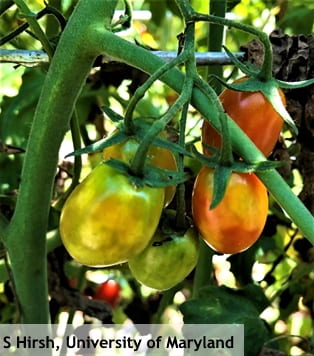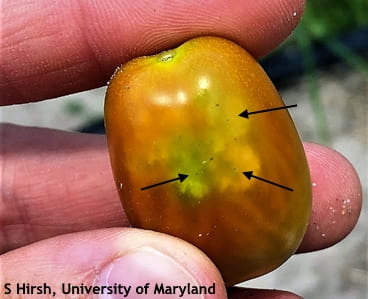I have seen and have gotten reports of (and some really nice pictures of) stinkbug damage in tomatoes over the past 10 days from all over Maryland including the Eastern Shore.
Stinkbug feeding damage is called cloudy spot in tomato fruit (Fig. 1).
It occurs when the adult or immature stinkbug puts its needle-like mouth parts into the fruit and removes material from a large number of cells. On green fruit the damage appears as whitish areas with a black dot in the center and indistinct borders (Fig. 2) on ripe fruit the spots are golden yellow (Fig. 1).
Individual spots may be 1/16 – 1⁄2 inch in diameter; or, the spots may merge and encompass a large area of the fruit surface (Fig. 2). Peeling back the skin shows these areas as white shiny, spongy masses of tissue (Fig. 3). This damage is usually most common from mid-July until the end of the season, but this year we started seeing it at the end of June.
The green and brown as well as the brown marmorated stinkbug are often difficult to see and usually go unnoticed as they spend much of the day deep inside tomato plants, any disturbance and the stinkbugs will drop to the ground and move under the plastic, which results in monitoring difficulties. Only a few are necessary to cause the appearance of cloudy spot on many tomato fruit. Although stinkbug damage has been observed in greater than usual amounts in tomato fields this year, observations of stinkbugs have been much less numerous.
Figure 2. In the center of each cloudy spot is a tiny black dot where stinkbug mouthparts penetrated into the tomato
Figure 3. Stinkbug feeding causing cloudy spot on tomato fruit
Stinkbugs are extremely difficult pests to control. As alluded to earlier, there are no good methods for monitoring these pests. Traps do not work well, visually scouting for them has proven to be unreliable and too time consuming. Usually stinkbug damage is only a nuisance, but so far this year it has resulted in moderate losses in some fields. Growers should examine the edges of their fields carefully for tomato fruit with cloudy spot.
There are some acceptable chemical choices for stink bug control. Pyrethroids (Warrior II, Hero EC, Tombstone and Mustang Maxx) or Venom or Scorpion can be used to reduce damage. Sprays should be directed towards the center of the plant with high pressure and a high gallonage (50-100 gal/a). If harvest has started there are neonics and pyrethroids that have very short PHIs – check your Mid-Atlantic Commercial Vegetable Production Recommendations guide.
It should be understood that none of the chemicals will give complete control but will reduce damage compared with no chemical usage. Organic growers can try Entrust or Azera or Pyganic for control of nymphs, but not for adults, i.e., these materials will not control adults.
Photo at top: Stinkbug feeding damage is called cloudy spot in tomato fruit (Fig. 1).
– Jerry Brust, IPM Vegetable Specialist, University of Maryland; [email protected]



















